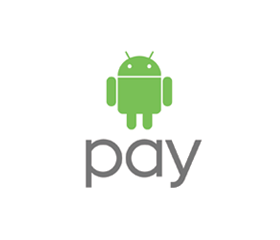Android Pay Signals Turning Point for M-Payments
By Kate Fitzgerald, Emerging Payments Editor
 If Apple Pay provided the first example of a mobile wallet with the right ingredients to finally ignite user (and partner) interest, Google Inc.’s Android Pay platform is poised to accelerate m-payments scale. Android Pay uses host card emulation (HCE) to support NFC transactions, encompassing most users of Android devices, and Google says the major U.S. mobile carriers will include it in all new Android handsets.
If Apple Pay provided the first example of a mobile wallet with the right ingredients to finally ignite user (and partner) interest, Google Inc.’s Android Pay platform is poised to accelerate m-payments scale. Android Pay uses host card emulation (HCE) to support NFC transactions, encompassing most users of Android devices, and Google says the major U.S. mobile carriers will include it in all new Android handsets.
With Apple expanding access to Apple Pay via Apple Watch, Samsung entering the market and Google’s upcoming Android Pay release, the m-payments ecosystem appears ready for liftoff.
Google late last week unveiled Android Pay, which enables bank apps to integrate with the platform via a secure tokenization approach, so consumers may add their credit and debit cards directly from bank apps for use to make purchases in Android apps and in stores, Google said. Google Wallet, which Google introduced in 2011, will continue to operate, supporting P2P payments within its mobile app for Android and iOS devices, along with a virtual prepaid MasterCard for online and POS purchases.
Visa, MasterCard, American Express, Discover and several large banks, including Bank of America and U.S. Bank, all announced support for Android Pay, which paves the way for broad issuer and merchant participation, analysts forecast. A key reason is the confidence participants can count on with Android Pay’s design, which relies on the same EMVCo tokenization specs as Apple Pay, and provides a level of security and consistency at the customer level for conducting contactless payments, Zilvinas Bareisis, a senior analyst with Celent, tells Paybefore. Where Apple Pay stores payments tokens on the embedded secure element and secures the transaction using a chip inside the handset, Android’s HCE approach generates and stores tokens in the cloud and the phone must download one of these tokens for each transaction, Bareisis explains.
Visa last week announced the Visa Digital Enablement Program and MasterCard unveiled the Digital Enabled Service, each specifically designed to facilitate the process to enable the secure, tokenized approach for Android Pay acceptance for credit, debit, prepaid and small business card issuers. “[Our new service] extends consumer choice and drives further ubiquity of payments on devices,” said Ed McLaughlin, MasterCard’s chief emerging payments officer.
Now that Android is available for a wider audience of smartphone users, are merchants ready? Though most payment terminal hardware supports NFC, only about 10 percent to 15 percent of the total number of U.S. merchants has enabled NFC so far, analysts estimate. But that’s changing as secure mobile payment services like Apple Pay and Android Pay take hold, according to Greg Burch, vice president of mobility, business development and ISV relationships for Ingenico Group. Ingenico, for example, supplies a toolkit for merchants to quickly switch on the NFC capability within its terminals, but enabling it involves further merchant legwork that could slow down NFC’s spread. “There’s a lot of other merchant prep work required to support NFC, including user interface design, making sure the look and feel [of the mobile payment experience] is consistent with other modes of checkout and testing proper function with their processor,” Burch notes.
Google said it’s working with top payments processors including Braintree, CyberSource, First Data, Stripe and Vantiv to ensure smooth integration for merchants.
Related stories:











































